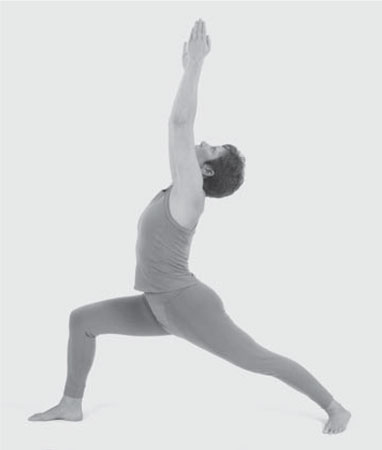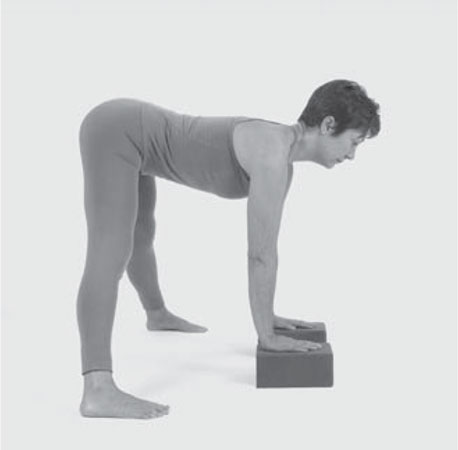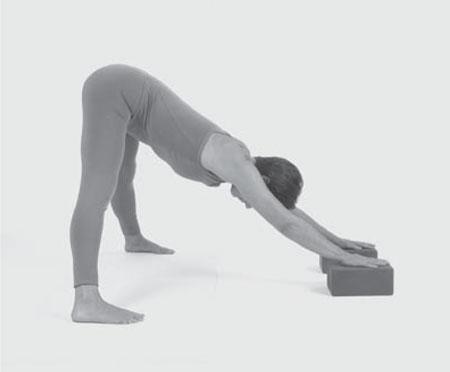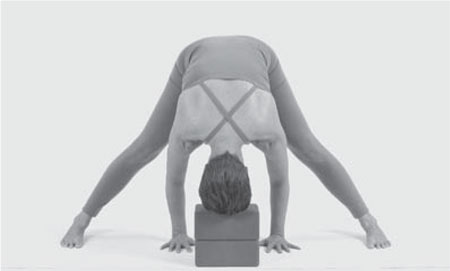Yoga for a Healthy Lower Back (24 page)
Read Yoga for a Healthy Lower Back Online
Authors: Liz Owen

After completing all four steps, change the cross of your legs and repeat the sequence. You should experience spreading across your whole sacral band, because this pose is particularly helpful for relieving tightness and tension in your sacrum.
Proud Warrior Pose
Stretch and Strengthen | Virabhadrasana I
Before you attempt to practice Proud Warrior, a strong standing pose that builds stamina while it expands stability and power in your hips and spine, be sure your body feels very comfortable in the
Supported Deep Lunge Pose with Variations
.
Stand in the center of your mat and step your feet about five feet apart. Turn your left toes slightly inward, and turn your right foot and leg ninety degrees to the right. Place your hands on your hips and turn your hips and torso to face your right leg. Balance your waist, chest, and shoulders from left to right. Place one hand on your lower abdomen and the other on the back of your hips. Drop your tailbone toward the floor and lift your hip bones up toward your chest, bringing your pelvis into the upright and neutral position that I described in the
Low Lunge Pose
.
Draw your shoulder blades down and away from your ears and press them forward, transforming them into hands that support and open your front chest (we'll talk more about this in chapter 6). On an inhalation, lift your arms up over your head, keeping your front chest broad. With your next exhalation, bend your right knee and drop your right hip toward the floor (
fig. 3.29
). Hold your left leg with strength so you have power in both legs to support your body. Look forward, or if you feel very stable, look up, letting your head dip behind your arms. Stay in the pose for fifteen to twenty seconds, and come out by reaching your arms even more strongly upward and straightening your right leg. Turn your feet in the opposite directions, and repeat Proud Warrior Pose on your left side.

FIG. 3.29
To alleviate any feelings of compression in your lower back, make sure your arms, ribs, and waist are all lifting upward; if you still have discomfort, lean your torso forward to make length in your lower back. But perhaps the best way to create comfort in your sacrum, hips, and lower back in Proud Warrior Pose is by maintaining neutral hip position throughout the pose. Be sure your tailbone is consistently dropping down toward the floor and scooping slightly forward, your hip bones are lifting upward toward your chest, and your navel is moving back toward your spine. Be sure to draw both your thighs toward your hips, as you did in Supported Deep Lunge Pose with Variations, so that your sacral joints come into balance.
In this challenging but empowering pose, breathe deeply down into your torso and visualize your Svadhisthana (sacral) chakra. Imagine this vital energy as your center of gravity and stability, expanding and supporting your sacrum through its strength. Breathe up into your chest and feel your heart becoming expansive and open. As your breath moves between your lower and upper torso, visualize the energies of prana vayu and apana vayu joining and uniting, creating an energetic oneness in your body. Feel a self-supportive sense of personal power and a sense of oneness as your parts unite.
Allow yourself to feel proud of your body for gaining the strength and flexibility to move comfortably through this pose.
Wide-Legged Standing Forward Bend
Stretch | Prasarita Padottanasana
After a strong pose like Proud Warrior, it's good to let your body rest for a few moments, but in a position where you can enjoy the feelings of strength and tone you've created in your legs, hips, sacrum, and spine. Wide-Legged Standing Forward Bend is just such a pose. In steps 1 and 2 you'll feel your spine lengthen and let go of tension and tightness, and as you move into the final step, your mind will have a chance to quiet down and experience the flow of energy in your spine.
Stand on your mat with your feet four to five feet apart, with a pair of blocks at the midpoint between your feet, slightly forward of your body. Feel your feet evenly grounded into the floor, and be careful not to collapse your ankles inward or overstretch them outward. Lift up through your legs, as if you were drawing the supportive energy of the earth all the way up your legs into your lower back. Bend forward from your hips and place your
hands on the blocks, making sure your hips stay aligned with your ankles so you don't tip forward.
Step 1: Half Wide-Legged Forward Bend
Lift your torso halfway up, elongating your waist, the sides of your trunk, and your lower back. Your torso should almost be parallel to the floor (
fig. 3.30
). If your spine is unable to lengthen in this manner, place your hands on the seat of a chair instead of blocks. Stay here for a few breaths and observe how lifting energy up through your legs stabilizes your body and helps you lengthen your trunk away from your hips, releasing tightness and tension in your lower back. Gaze forward if your neck is comfortable. You can increase neck comfort by drawing your shoulder blades away from your neck. If your neck is in discomfort, look down at the floor.
Step 2: Half Wide-Legged Spine Lengthener
With the next few exhalations, move your blocks or chair away from your body, reaching with your arms and elongating your torso and your spine. Keep your hips directly over your ankles so your lower back gets the benefit of gentle spinal traction. Your trunk will be at an angle to the ground nowâthe farther you reach your arms and trunk forward, the closer your shoulders will come toward the floor (
fig. 3.31
). Hold this stretch for a few breaths while your spine reconfigures to a new length.

FIG. 3.30

FIG. 3.31
Step 3: Full Forward Bend
Release your props and walk your hands along the floor back toward your body, until they are in line with your feet. Release your trunk, shoulders, and head straight down toward the floor. Rest the crown of your head on the floor, on a block, or even on a pile of blocks, however you can allow your head to connect to the earth. Visualize the supporting energy of the earth flowing up through your legs and hips, into your trunk and spine, with each inhalation. Feel your lower back relaxing and releasing, energy pouring freely along your spinal muscles from your sacral joints to the nape of your neck (
fig. 3.32
). Visualize the central channel of your spine, the Sushumna, as a luminescent core of energy around which Ida and Pingala dance, and where they come together at each chakra, visualize points of light that illuminate your path to wellness.
Although Wide-Legged Standing Forward Bend isn't an inversion (in an inversion, your legs are higher than your heart), it gives you some of the restful benefits that inversions offer: The easy flow of blood from the torso to the heart, because it is aided by gravity in this pose, signals the heart to beat slower and reduce the strength of its contractions.
13
Further, the stimulation of the vagus nerve (we'll talk about this more in chapter 5) in a head-down position elicits the relaxation response of the parasympathetic nervous system.
14
To come out of the pose, come back into step 1 by walking your hands under your shoulders and lifting your trunk halfway up. As you start to come up, be sure to listen to your sacrum, which has been given an awakening, enlivening yogic experience. If it is happy, come up with your hands on your hips, your legs strong, and your spine lifting straight up. But if you sense any discomfort across your sacral band, place your hands on your hips, bend your knees slightly, and slowly roll your spine up to a vertical position. Walk your feet together and stand tall in Mountain Pose for a moment. Feel your whole back body filled with freely flowing energy that travels from your feet up along your back all the way to the crown of your head before sinking back down into your feet, grounding you to the earth.

FIG. 3.32
Child's Pose and Deep Relaxation
Rest | Balasana and Shavasana Variation 2
It's important to completely rest your body after every practice, and that's especially true when you are exploring more rigorous poses such as those in this section. Rest in
Child's Pose
for one to two minutes and then in
Deep Relaxation
for as long as ten minutes if you have the time. Support your sacral band for absolute comfort and let your body completely relax into the support of the earth.
4
I
F THE SACRUM
is the “heart” of your spine, then the five vertebrae that make up your lumbar spine form a major “artery” carrying nourishment, energy, and support up from your core, through your trunk, and toward your upper body.
Like the sacrum, the lumbar spine is a chronically neglected region of the modern human body. The word itself sounds tight, stiff, and clumsy. (Confession timeâdid you ever think it was spelled “lumber”?) You've no doubt noticedâand possibly invested inâthe industry offering “lumbar support” pillows for planes, trains, and automobiles, your desk chair at work, or a night at the movies. If you're among the millions of Americans who has visited a doctor complaining of “back pain,” chances are your lumbar spine has been part of the problem.
1
The reason for this is that the lumbar region has a lot of work to do. Most of your body weight is borne by its musculature, and most of the movement your back is capable of comes from this area of your spine. All this responsibility can leave your lumbar spine vulnerable to injury and strain.
Unless, of course, you know how to take care of it, which is where the yoga practice in this chapter comes in. When it comes to the lumbar spine,
the physical work in yoga is to create as much balance as possible while respecting and honoring structural conditions and limitations. In this chapter you will explore your own lumbar spine, and with yoga, you will create your body's natural tone and balance.
T
HROUGH
W
ESTERN
E
YES: THE
P
HYSICAL
V
IEW